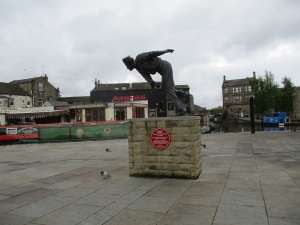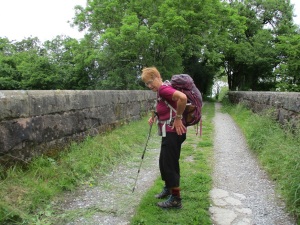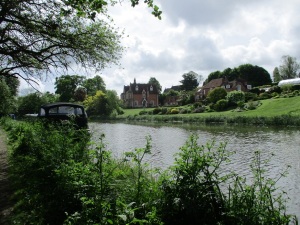We have geocached twice before in Eversley. The first time was during April 2021, when we met another cacher Mikes54. He was out and and about undertaking preliminary work on some new caches he was about to set. We were reminded of these caches when we saw Mikes54 on the ‘Balls’ round (November 19 posting).
So we headed to Eversley to undertake five caches.
Three of the caches were Counting Vowels multicaches, where we had to visit various waypoints, find a sign, and write down a word or two. Then once we had all the words, we could count each vowel and use the numbers in an equation.
The first Counting Vowels waypoint was at a field boundary, but the second was adjacent to a cache we had DNFed back in April 2021. The cache was hidden in or near a bridge. The bridge led to someone’s back garden, and our reticence to explore on the owner’s side of the bridge last time was why we couldn’t find the cache. This time we came armed with information from Mikes54.
He told us where the cache was (the fact we didn’t quite remember what he exactly told us, is irrelevant) . The bridge seemed to be in a poorer state of repair than we remembered. The iron was rusting, holes were appearing in the bridge, and it looked decidedly unsafe. Mr Hg137 tentatively walked across, and then stood and searched the bridge. The rusty bridge caught his finger, so as he searched he nursed a cut. After changing position so that he was astride the stream, the cache was found, thrown to Mrs Hg137 for signing, before replacing. A tentative walk back over the bridge and we resumed our walk ‘counting vowels’.



We walked along the path arriving at a seat. We now had all the words, and hence vowels, and we quickly did our calculation. (By this time Mr Hg137, had a facemask, bandaged around his cut finger). We walked across a play area to the cache, as we blundered our way across some low lying brambles, Mrs Hg137 realised she didn’t have her geopole. Whoops! Where did she leave it ?
It was decided she would retrace her steps, while Mr Hg137 looked for (and found!) the cache. As he left the cache site, and was walking back through the play area, he met Mrs Hg137 returning. The geopole was by the ‘bridge cache’ – Mrs Hg137 had put the pole down to receive the ‘thrown cache’!
A big sigh of relief. We were still chattering away as we arrived back at the bridge cache. This time the owner was peering over the fence, just as we were taking a picture of the bridge. Had he seen us last time ? Did he know there was a cache in his bridge ? We made polite conversation and established he doesn’t use the bridge anymore, as it is so rickety and dangerous. Mmm – maybe he doesn’t know about the cache,
Our next set of caches were at Eversley Church, about half a mile away. We crossed a couple of fields, and were watched by several horses. Some inquisitive, some taking the attitude ‘I know you are there, but I’m going to ignore you’.
The church was one of the few recommended parking slots for the walk. We were grateful we had opted not to us it, as the car park was full. A couple of horseboxes had parked up, as well as twenty or so cars.
We soon discovered why – it was the Church’s annual clean up. There was gardening work going on the graveyard, there was a myriad of people inside – cleaning, tidying and polishing (the smell of polish was incredible). Decorations were going up for Advent, and there was a wedding due in the afternoon. Busy, busy busy – we didn’t linger long inside.We were though told about Charles Kingsley’s grave. Charles Kingsley was the author of “The Water Babies” and had been the rector of the church from 1844.
Conveniently the grave was next to one of the many waypoints we needed for our next Counting Vowels cache. We quickly collected the vowels and strode away from the church and shortly afterwards arrived in quieter countryside to search for a geocache. A quick find later and we returned to the church to find a standard cache opposite the lych gate (part of the Church Micro series of geocaches). This cache took a bit of careful choreography to find, as the churchyard gardening work was close by – every time the ‘gardener’ bent below the wall, we bent down and searched !
Our final cache of the day, was another counting vowels. This time we were led down a partially-tarmacked road, and we collected out names from various objects along the way. This should have been a quiet road, but we stopped on at least three occasions to let a car, a cyclist and a horse rider go by.
Having collected the vowels, and found the cache, we returned to the church on our way back to the car.
A man stood overlooking the gate, near to where we had found an earlier cache. Was he a cacher ? No he wasn’t.
He had in his hand a satellite image of the graveyard, and he was marking on that image, where the various War Graves were. We assumed the War Graves Commission would have the exact location of each grave, but they only list the graves in the general graveyard, not an exact location. The man we chatted to, had about 5 or 6 graves to find and mark, so we left him to his work as we completed our work celebrating 5 found caches out of 5.
Here are a couple of the caches we found :






































































































































































